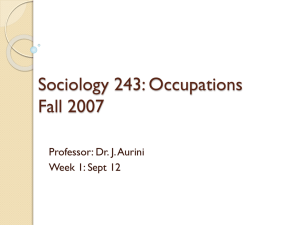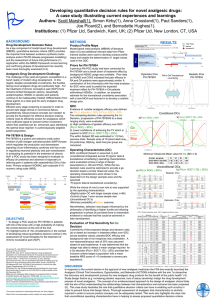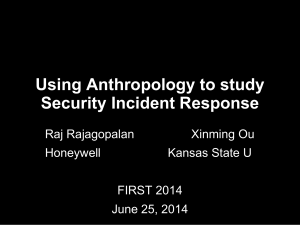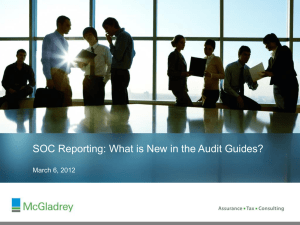Inception Presentation
advertisement
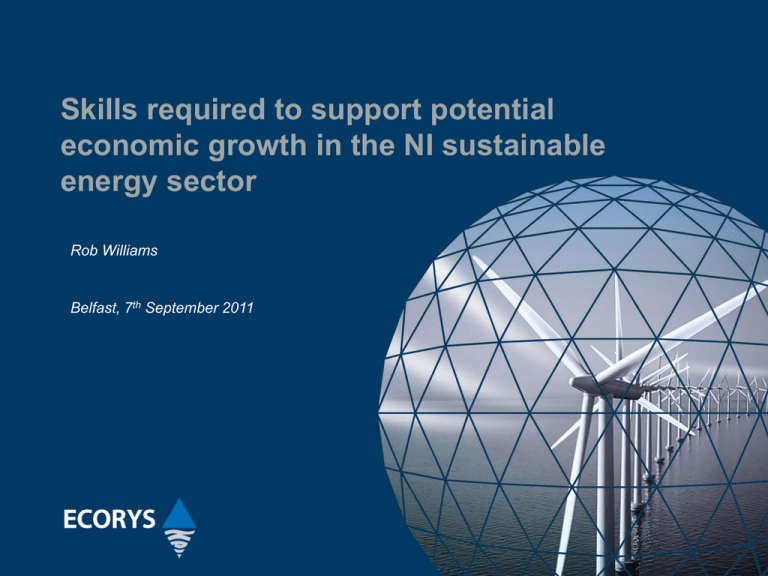
Skills required to support potential economic growth in the NI sustainable energy sector Rob Williams Belfast, 7th September 2011 Presentation Structure 1. Scope 2. Approach 3. Results • Current sector size and nature • Prospects and barriers • Skills supply vs. demand 4. Conclusions and policy remarks Scope • To achieve the following outputs: ◦ ◦ ◦ ◦ ◦ ◦ Estimate the current size of the Sustainable Energy (SE) sector in NI Estimate the future potential growth rates in the SE subsectors Model the staff / skills profiles in each of the sectors Apply the growth rates to the current sector size and profile to estimate future skills needs Analyse the current supply of relevant skills Compare the supply of skills to the future demand for skills to illustrate what gaps between supply and demand may develop Scope – Sustainable Energy Sectors • • • • Integrated Building Technology ◦ Energy efficiency and renewables in new and existing buildings. ◦ Large energy user, large amounts of buildings to be refurbished, large employer. Offshore Energy ◦ Offshore wind, wave and tidal. ◦ Large resource, wind developing, wave and tidal research skills. Bioenergy ◦ Production and utilisation of biomass for energy. ◦ Large resource and new and diversified employment opportunities. Energy Storage ◦ Storage of electricity (and gas), Smart grid. ◦ Key enabling technology with global potential. Approach • Involved a combination of: ◦ Literature review, company survey (140 from 450), consultations (40+), workshop and modelling • Sector size and profile ◦ ◦ ◦ ◦ • Based on BIS Low Carbon and Environmental Goods and Services (LCEGS) descriptions Fractions of the four digit SIC codes – number of companies employment, GVA Reality tested via consultations and survey Typical skills profiles for sectors, refined via survey Market growth ◦ Annual growth rates to 2020 ◦ Wide variety of sources, low to high scenarios ◦ Not just NI, not aiming at ‘self sufficiency’ Current Sector Size and Nature Current (2010) Estimate of the Turnover and Size of the Sustainable Energy Sector in NI Sustainable Energy Sector GVA £m Number of companies Employment Integrated Building Technology 92.1 634 1,798 Offshore Energy 31.7 94 476 Bio Energy 26.0 239 1,106 Energy Storage 25.6 73 526 Total 175.4 1,040 3,906 0.92% 1.52% 0.56% Share of NI Total (GVA, No. companies and Employment) Source: Ecorys Modelling • Confident in order of magnitude, but estimate – Part of larger sectors – Fast moving and fluid – International Current Sector Size and Nature NI SE Sectors SOC 9 Elementary Occupations 5% SOC 8 Process, Plant and Machine Operations 20% SOC 2 Professional Occupations 19% SOC 6 Personal Service Occupations 2% Source: Ecorys Modelling • SOC 1 Managers and Senior Officials 17% SOC 9 Elementary Occupations 10% SOC 8 Process, Plant and Machine Operations 9% SOC 7 Sales and Customer Service Occupations 5% SOC 5 Skilled Trades Occupations 15% Whole NI Economy SOC 4 Administrative and Secretarial Occupations 9% SOC 3 Associate Professional and Technical Occupations 8% SOC 1 Managers and Senior Officials 11% SOC 2 Professional Occupations 12% SOC 7 Sales and Customer Service Occupations 7% SOC 3 Associate Professional and Technical Occupations 12% SOC 6 Personal Service Occupations 9% SOC 5 Skilled Trades Occupations 16% SOC 4 Administrative and Secretarial Occupations 14% Labour force survey Staffing profile ◦ High skilled ◦ Manufacturing focus, lower input from sales and support ◦ Technology development, some at early stage Prospects and Barriers Annual Growth Rates to 2020 for Sustainable Energy Sectors (and Sub-sectors) Sub Sector Annual Growth of Market Size to 2020 (%) Low Central High Integrated Building Technology 5.5 10 15 Offshore - wind 17 27 32 Offshore - wave, tidal 7 26.5 40 Bioenergy -electricity 5.7 6.7 29 Bioenergy -heat 3.9 9.4 22 Bioenergy -transport 6.2 9.5 13.8 3 4 6 Energy storage • • Multiple sources. E.g. – BIS, Renewable Energy Action Plans, Sustainable Energy Authority Ireland If NI is to meet 40% of its electricity demand from renewables by 2020, generation would need to grow by 13% per year Supply of Skills – Large proportion of skills and educational requirements of the SE sector are not new – Science, Technology, Engineering and Maths (STEM) core skills are key. – FE and HE provision of entirely relevant courses (e.g. electrical engineering) and relevant units within other courses (e.g. biomass within a land management course). – Carbon Zero Project – collated existing provision and helped develop new and additional. 526 enrolled in 09/10. – Some strong research and teaching skills in HE – e.g. Questor at Queen's, UU School of the Built Environment. – FE has large numbers enrolled in relevant areas (e.g. 2009/10 - 7,172 engineering and 9,781 construction) – Had to estimate what % of ‘generalists’ will go into SE Demand vs. Supply Demand - Projected to increase from ~500 annually in 2011 to >860 in 2015 (central) 5000 High 4500 Annual SE skilled workers required Supply - Base skills (engineering) allocated to and between sectors by relative size - Est. ~350 skilled people supplied each year Projections of Skiiled Worker Requirements in the Sustainable Energy Sector in NI 4000 3500 3000 2500 2000 Central 1680 1500 1000 863 500 420 Low 0 2011 2012 2013 2014 2015 2016 2017 2018 2019 2020 Demand v Supply • Annual gap between supply & demand, est ~175 / year Average Annual Gap Between Skills Demand and Supply for the Sustainable Energy Sector in NI 125 Offshore Energy 100 Integrated Building Technology 75 Individuals • Biggest gaps in Offshore Energy and IBT • Only small / no shortages in Bioenergy and Energy Storage 50 25 • Total gap of around 900 by 2015 – Over 500 in Offshore Energy Energy Storage 0 Bio Energy -25 Conclusions (and uncertainties) Demand – Clearest short term need in offshore wind – Demand in IBT and Bioenergy should grow steadily – Strong medium to long term opportunities in wave, tidal and the Smart Grid – Government energy policy lead and clarity is key to demand – There is a need for multidisciplinary skilled workers – Export focus for NI companies is vital for growth, but needs support – Availability of funds to support courses, upgrade the grid and provide other SE growth assistance is an issue Conclusions (and uncertainties) Supply – The decline in numbers of those pursuing high level mechanical and electrical engineering courses is a concern – Co-ordination between skills providers is growing and should continue to be encouraged – Some skills gaps could be filled by attracting back expatriot NI workers – Supporting and developing STEM skills is arguably more important than trying to match specific needs Conclusions (and uncertainties) Supply vs. Demand – Multiple assumptions required introduce uncertainty – Ideal to match supply and demand ◦ Avoid over and under supply ◦ Requires close cooperation between companies and skills providers ◦ Could export ‘surplus’ skills ◦ High risk to use public funds in anticipation of demand – Skills need of large incoming SE companies best met by providing labour market entrants with STEM skills Policy Remarks - Short Term Skills Provision • Develop capacity in offshore / marine technician training Skills Policy • Consider ensuring relevant FE course are on the priority support list • Support apprenticeships in SE Other • Use SE to promote STEM skills Policy Remarks - Medium Term Skills Provision • Continue the dialogue between industry government and skills providers in order to anticipate and meet specific skills needs as they emerge • Develop capacity to retain the developed skills in Integrated Building Technology • Modify the content and branding of some HE courses to include SE content and references . Skills Policy • Link with Scotland and the rest of the UK in SE promotion and skills development • Continue to support the developing SE specialisations of the FE providers Other • Ensure that the planned efforts to publicise and present the policy vision for SE in NI reach industry and the general public effectively • Communication and education by the network owner and operator and the Utility Regulator on the plans and efforts underway to improve the structural integrity and energy storage potential of the grid • Continue support for SMEs wishing to enter, or increase their activity in, the SE sector Policy Pointers - Longer Term Skills Provision • Retain and develop the SE skills in the HE sector Other • Consider linking to future ‘Homecoming / C’Mon Over’ campaigns (or equivalent) to attract back ex patriot workers in SE. Thank you Contact Details Rob Williams Associate Director 0121 212 8856 07920 494 798 rob.williams@uk.ecorys.com
